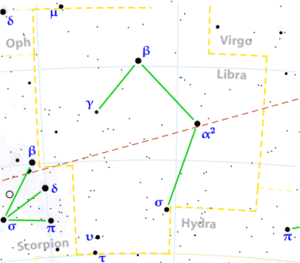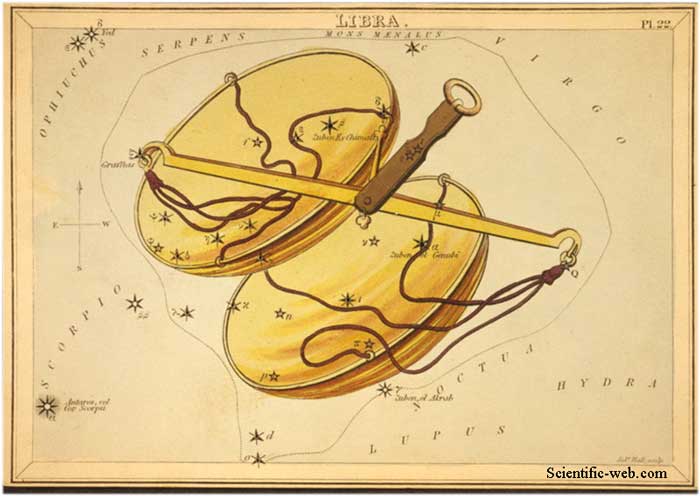
|
Libra ( Latin: balance, symbol , Unicode ♎) is a constellation of the zodiac. Fairly inconspicuous, with no first magnitude stars, it lies between Virgo to the west and Scorpius to the east. As the names of the brighter stars testify, it once represented the claws of Scorpius. Notable features The brightest stars in Libra form a rectangle: * α Librae, Zubenelgenubi ("southern claw"), a visual binary; * β Librae, Zubeneschamali ("northern claw"); * γ Librae, Zubenelakrab ("scorpion's claw"); * σ Librae, Brachium an eclipsing variable. α and β Librae are the scales' balance beam, and γ and σ are the weighing pans. σ Librae was formerly known as γ Scorpii despite being well inside the boundaries of Libra. It was not redesignated as σ Librae until 1851 (by Benjamin A. Gould). Mythology The constellation, which had originally formed part of the claws of the scorpion (Scorpio), is the youngest of the Zodiac and the only one not to represent a living creature. In later Greek mythology, the constellation, which when considered on its own looks vaguely like a set of scales, was considered to depict the scales held by Astraea (identified as Virgo), the goddess of justice. Astrology The Western astrological sign Libra of the tropical zodiac (September 23–October 22) differs from the astronomical constellation and the Hindu astrological sign of the sidereal zodiac (October 31–November 22). In some cosmologies, Libra is associated with the classical element Air, and thus called an Air Sign (with Aquarius and Gemini). It is also one of the four cardinal signs (along with Aries, Cancer, and Capricorn). Librans are the diplomats of the Zodiac. Their polar opposite is Aries. It is the domicile of Venus and the exaltation of Saturn. Each astrological sign is assigned a part of the body, viewed as the seat of its power. Libra rules the lower back and kidneys. The symbol for Libra is the Scales, making it the only sign of this zodiac whose symbol is not a living creature. Graphic visualization The stars in the constellation Libra can be connected more fully, graphically showing a balance. The star beta Librae, of third magnitude, represents the top of the balance. The stars gamma Librae and alpha Librae represent the balance beam: alpha Librae being of third magnitude as well. The stars upsilon Librae and tau Librae represent the left plate of the balance, whereas the star sigma Librae represents the right plate of the balance. All three of these stars are of the third magnitude. History "Scorpion's claws" is zubānā in Arabic and zibanitu in Akkadian. In ancient Mesopotamia, a weighing scale was often the arm and the pans without a stand, and to use it was hung up by a string tied to the midpoint of the arm. A resulting fancied resemblance to a scorpion hung up by the end of its tail resulted in the Akkadian word zibanitu also being used to mean "weighing scale". The constellation was refigured by taking the other meaning of zibanitu. Planetary System Recently, Gliese 581 c, the first Earth-like extrasolar planet to be found within its parent star's habitable zone, has been found in orbit around the star Gliese 581 in the constellation Libra, raising the question of whether it has life.[1]
1. ^ SPACE.com - Major Discovery: New Planet Could Harbor Water and Life References * H. A. Rey, The Stars — A New Way To See Them. Enlarged World-Wide Edition. Houghton Mifflin, Boston, 1997. ISBN 0-395-24830-2. * Ian Ridpath and Wil Tirion (2007). Stars and Planets Guide Links
Retrieved from "http://en.wikipedia.org/"
|
|
||||||||||||||||||||||||||||||||||||||||||||||||||||


